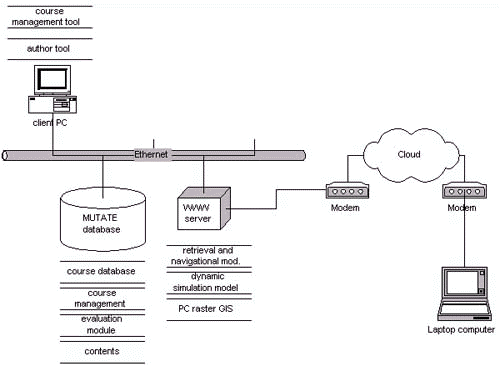 |
| THE
EDUCATIONAL APPROACH IN THE EU PROJECT MUTATE (MUltimedia Tools for Advanced gis Training in Europe) |
| Joäo Ribeiro Da
Costa Chiron, Sistemas de Informação, Lda, Edificio UNINOVA, Quinta da 2825 Monte de Caparica Portugal, tel. 351- 1- 2943713 / 3500278 ,telefax 351- 1- 2943710, e.mail: jrc@chiron.pt Mauro Salvemini Abstract MUTATE, Multimedia Tools for Advanced GIS Training in Europe, a R&D Project funded by the Educational Multimedia Task Force of the European Union, emerged from the practical experience of a multi-national team of SME's and universities. Having started in January 1998, MUTATE has a two year lifetime. Its ultimate goal is the creation of a set of tools, designated MUTATE Bundle, which will allow the development of Web Based Advanced GIS Training and Education, thus opening the door for Universities to introduce a new type of educational service, multimedia, Internet based, which can be offered world-wide, making the most of the European know-how and, through the implementation of real cases demonstrate the validity of the concept. From 1999 onwards European citizens will benefit from a new offer in advanced training, made available on an equal basis to every European, from southern Portugal to northern Sweden. Any technician willing to attend a course of world reputation, with the world leading experts as directors and tutors just needs a normal PC and a phone line. Universities will have the chance to generate a new source of income, using their main asset: the pool of teachers and researchers. The idea MUTATE is a R&D Project funded by the Educational Multimedia Task Force of the European Union, whose ultimate goal is the creation of the new tools for Web Based Advanced GIS Training and Education. The main steps in the project are:
A new pedagogical approach MUTATE proposes an innovative pedagogical approach, ultimately aiming at finding out new means of conveying knowledge from experts and a pool of knowledge to students. This approach is based on the following principles:
There is increased evidence of the advantages of Multimedia training: "The multimedia approach saves time-anywhere from 25% to 50%, with most reports showing a 35% to 45% decrease in training time. This savings is achieved with equivalent or better learning gains in terms of retention (remembering what was learned) and transfer (using what was learned)." The products MUTATE will produce a Software Bundle (to be shipping in 1999), the MUTATE Bundle, which includes several modules:
MUTATE Bundle is installed in a Server machine, integrating an ORACLE database server and a WebServer. The structure of the MUTATE based courses is such that different parts can be run by different computers, for instance dynamic simulation models may be run in super-computers anywhere in Europe. Management and development modules are client server programs; Student tools are accessed through the WebServer, and includes HTML contents, XML contents, ActiveX controls and JAVA applets. The services MUTATE will also provide two types of services: Web Based Training Services and Content Development Services. The main characteristics of the MUTATE Web Based Training Services are:
MUTATE Content Development Services include creating or organising contents for specific courses, other than the Open GIS Course. The users MUTATE has two types of users in mind:
To test the MUTATE products four well known universities, scattered around Europe, were selected. In order to demonstrate the potential of the proposed approach and training philosophy end user involvement was taken one step further and MUTATE is involved in the launch of the European Open WebGIS Course as an example of the new type of course. GIS training The needs
These agents have a background in different areas of knowledge, including Sciences, Social Sciences or Information Processing and Decision. Depending on the task they have to perform in their respective organisations these different agents will require different training offers. However a common structure may be defined, along three main topics: Understanding GIS, Performing geographic analysis and Analyse decisions on the basis of a GIS. European Internet Open GIS Course Starting in 1999, the European Internet Open GIS Course will be centred in the University of Utrecht and will offer four courses: I) a environmental analysis and geostatistics course; II) a GIS and decision making course; III) a GIS and planning course; and a IV) geomatics course. MUTATE Consortium The MUTATE consortium was conceived in order to get the proper mix of academic entities, with the scientific and pedagogic competence to support such an initiative, and private companies with a reputation for the development of innovative software products, guarantying that the final tools developed have support in the future and that they will be exploited commercially. The consortium includes seven partners, under the co-ordination of Chiron:
|
     |
    |
 |
| [Introduction] [Conference programme] [Presentation
by authors] [Presentation by category] [Poster session] [List of european Esri distributors] [List of exhibitor] [Esri products news] [Credits] |
